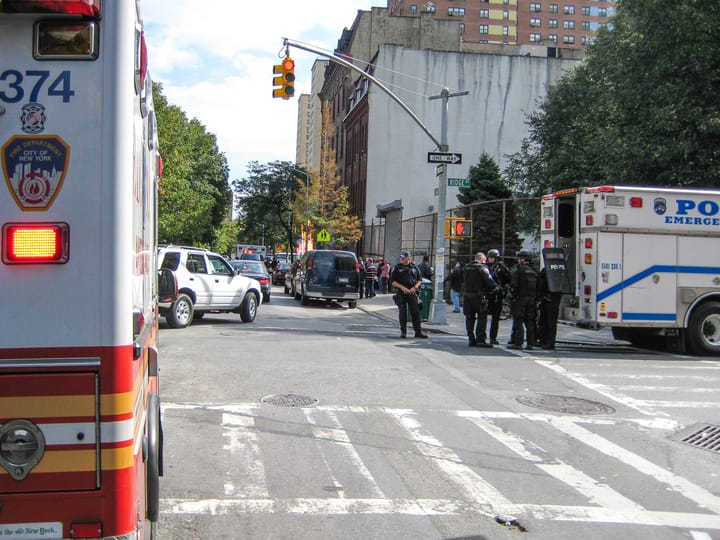Incident on the LES
New York, NY, USA
When I came out of my building, the street was full of ambulances and police vehicles. A group of officers in body armor and ballistic helmets, carrying submachine guns, were standing next to a big white ESU truck, watched by an interested crowd. I took a look and decided that whatever was going on was probably worthy of a few photographs, and went back to get my camera.
As I worked my way up and down the street, taking pictures, an elderly Dominican man came up to me.
“What’s happening?”
he asked.
“Someone said there’s been a shooting at 210,”
I said. For some reason this seemed to strike him as funny.
“Ah, the Lower East Side,”
he said, laughing. “Always some —”
followed by a word that might have been ‘atrocity’ or ‘absurdity’ but probably wasn’t either.
Whatever had happened seemed to be winding down. The ambulances left one by one: I don’t know if they were carrying away any casualties or if they had simply been ordered up in expectation of a firefight and had gone away disappointed when nothing violent took place. The ESU men, for all their warlike attire, didn’t seem to be particularly tense. A couple of stout, be-suited detectives stomped down the street, while a group of uniforms formed a cordon around the entrance to the building.
A young woman who told me that she used to be a police officer pointed to three men carrying ballistic shields and tools.
“Look,”
she said, “they got a ram. They’re going to break in somewhere.”
“Actually, I think they’re going home,”
I said. She looked relieved.
“Oh good,”
she said, “But there are the detectives. And the captain’s here — you see, in the white shirt?”
I thought to myself that every time I’d seen white-shirted officers on the street, they seemed to be busy complicating otherwise manageable situations. I didn’t say that to my new friend, but for all I knew, she might have agreed.
The detectives were frowning, listening intently to their walkie-talkies. They were both dressed in dark suits with big colorful ties, their shields clipped to their lapels. I wanted to ask the woman why homicide detectives always dress like they’re going to a wedding. Maybe it instills fear in the criminal mind to be faced by someone who looks like he’s just been hauled out of a reception. Maybe they really had been on their way to a wedding. That could explain why they seemed so irritated.
“Oh well,”
she said. “I gotta go. Hope you got some good pictures. Enjoy.”
‘Enjoy’ seemed a funny thing to say under the circumstances. How did you like your homicide? Oh, I had a wonderful time, thank you.
It looked as if whoever had been shooting was now either in custody or somewhere else. The ESU men from the other trucks (three ESU trucks had turned out in all, plus four or five squad cars and two canine units) had put their door-breakers away, and the detectives and the captain were long gone. One of the dog-handlers was busy chatting with the assault team, but his colleague was making a desultory search of the neighborhood. His German shepherd, shut in the vehicle, barked furiously, apparently resentful at being left out of the fun.
